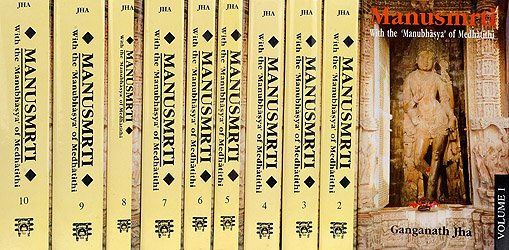Manusmriti with the Commentary of Medhatithi
by Ganganatha Jha | 1920 | 1,381,940 words | ISBN-10: 8120811550 | ISBN-13: 9788120811553
This is the English translation of the Manusmriti, which is a collection of Sanskrit verses dealing with ‘Dharma’, a collective name for human purpose, their duties and the law. Various topics will be dealt with, but this volume of the series includes 12 discourses (adhyaya). The commentary on this text by Medhatithi elaborately explains various t...
Verse 3.88
Sanskrit text, Unicode transliteration and English translation by Ganganath Jha:
मरुद्भ्य इति तु द्वारि क्षिपेदप्स्वद्भ्य इत्यपि ?? ।
वनस्पतिभ्य इत्येवं मुसलोलूखले हरेत् ॥ ८८ ॥marudbhya iti tu dvāri kṣipedapsvadbhya ityapi ?? |
vanaspatibhya ityevaṃ musalolūkhale haret || 88 ||Saying “this to the Maruts,” he should make an offering at the door; also one in water, saying, “this to the Apas;” and he should hake an offering on the pestle and mortar, saying, “this to the Vanaspatis.”—(88)
Medhātithi’s commentary (manubhāṣya):
The particle ‘iti’ is meant to lay stress upon the exact form of the words to be used.
‘In water’—this specifies the receptacle of the offering; and ‘to Apas’ indicates the deity to whom the offering is to be made.
‘Saying “this to Vanaspatis,” on the pestle and mortar; the singular number in the Copulative Compound ‘musalolūkhale’ would indicate that the two things are not two optional alternative receptacles; and, since two receptacles are mentioned, the right. course would appear to be that there should be a repetition of the oblation, which is the principal factor; specially, as it is not possible for the pestle and the mortar to be unified and then serve as a receptacle for the offering; as the two will ever remain distinct; they can never be mixed up like milk and water; so that if the oblation is poured on the mortar, it is not poured on the pestle; and if it is poured on the pestle, it is not poured on the mortar; nor is it possible for the oblation to be poured in parts (over the two receptacles); as the exact quantity of the oblation has been fixed by law. With all this, in view of the copulative compound, it appears best that the oblation should be poured on one of the two things mentioned (i.e., either on the pestle or on the mortar).—(88)
Explanatory notes by Ganganath Jha
This verse is quoted without comment in Vīramitrodaya (Āhnika, p. 402).
Comparative notes by various authors
(verses 3.84-93)
See Comparative notes for Verse 3.84.
